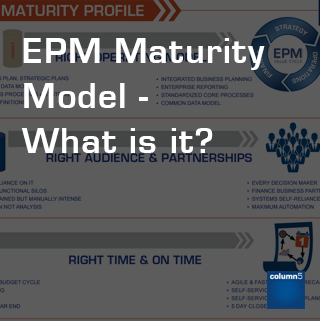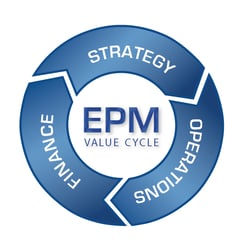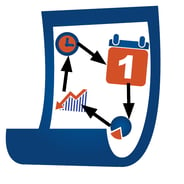 Organizations need to plan, measure and manage across Strategy, Operations and Finance. Isn’t that what Enterprise Performance Management (EPM) is all about? It seems like a simple formula. But what about if we change the question to ask what makes successful EPM and successful organizations? If we start with the definition that “Successful EPM drives organizations that dramatically outperform their competitors in terms of both financial and non-financial results” – this gives a very different perspective on the importance and value of EPM. It also means that you need to have a mechanism and framework to objectively review your EPM capabilities and relative maturity.
Organizations need to plan, measure and manage across Strategy, Operations and Finance. Isn’t that what Enterprise Performance Management (EPM) is all about? It seems like a simple formula. But what about if we change the question to ask what makes successful EPM and successful organizations? If we start with the definition that “Successful EPM drives organizations that dramatically outperform their competitors in terms of both financial and non-financial results” – this gives a very different perspective on the importance and value of EPM. It also means that you need to have a mechanism and framework to objectively review your EPM capabilities and relative maturity.
So where do you start in developing “Successful EPM”? Like any other area that you want to improve and be more successful at – it starts with understanding with how you define, measure and implement EPM. Many people are familiar with the different EPM software that is available today. However, the software itself is only an enabler of “successful EPM”. To understand and drive value from EPM you need an EPM Maturity Model that:
- Measures where you are currently in your EPM
- Gauges how well you are in succeeding in EPM
- Prescribes where and how to improve your EPM approach
So what does an EPM Maturity Model contain? And how do you use it?
Let’s start with the Maturity Model and what it needs to contain. To objectively profile the EPM maturity of an organization, we need to be able to describe:
- The Right (EPM) Model of the organization
- The Right EPM Audience
- The Right Time
 The Right Model
The Right Model
The model needs to contain the appropriate data and business rules and business drivers that support the actionable decisions throughout an organization. We give the model two primary axis to define the organization coverage: - Horizontal Integration
- Vertical Integration
Horizontal integration focuses on the needs and relative integration of an organizations Strategic, Operational and Financial planning and performance management processes. The matching to organizational needs and cross process integration is the primary determination for enabling businesses to “dramatically outperform their competitors in terms of both financial and non-financial results”. The processes for EPM need to have a model with the relevant data, rules, calculations and drivers that directly supports and integrates Strategic, Operational and Financial planning and decision making. As a consequence, integration with all the relevant data sources is needed in an integrated data model to support the three primary EPM processes.
Business rules, drivers and calculations need to be responsive and scale to the demands of the model and modeling needs of the organization. Importantly, they need to be defined and definable in an experience that business planners and business analysts can directly interact with. It will ultimately be in the area of business rules, drivers and calculations responsiveness that will determine the flexibility and agility of the model to support changing business conditions and how well, from a maturity perspective, that the EPM processes support the organization.
Vertical integration specifies the level of data granularity and volume, the relation between business rules and business drivers, to support the EPM processes. The level of data granularity is determined by the level of detail the planning is done to support meaningful or actionable decisions and analysis. With more data sources entering in to the EPM space, more granular data and significantly more data volumes, care needs to be taken not to overwhelm EPM processes with “raw data”. The relative maturity of a model along the Vertical axis is not determined by data quantities available but the relevance of the data and the context it is presented in.
 The Right Audience
The Right Audience
The Right Audience describes the stakeholders and decision makers as the primary users of EPM. Explicitly it means the people who need EPM capabilities in their role get the support from the EPM process. The definition of a decision maker is an important one. This is a person who needs to make decisions concerning organizational resources that drive the creation of enterprise value which ultimately gets measured in financial terms. This definition is not restricted to organization managers, but applies to people at all levels of an organization. How far EPM processes reaches the Right Audience is an important part of the Maturity gauge. The EPM user experience is also an important maturity rating, relating the intuitiveness, familiarity and ease of accessing and interacting with the EPM process.
 The Right Time
The Right Time
Timing is everything when it comes to planning and decision making in the context of EPM. Reducing the time to formulate plans and forecasts and communicate these to the relevant audience is fundamental aspect of EPM Maturity. Being able to work with “fresh”, up to date plans, forecasts and data has two important aspects:
- Reducing the time taken for planning and forecasting as mentioned above
- Increasing the frequency for planning and forecasting
Increasing the frequency relates to being able to produce rolling plans and forecasts with the relevant level of latency. This can extend in to the notions of near real-time updates to plans and forecasts where it’s valuable to do so. At the heart of the Right Time is the importance of organization being to identify, plan and act to different business conditions and events in a timely and seamless approach that maintains the integrity and relevance across Strategic, Operational and Financial EPM processes.
In the next article we’ll in to how to gauge EPM Maturity using the EPM Maturity Model and how to identify areas to improve and drive real success.
We will also be discussing more about the EPM Maturity Model at the upcoming EMEA EPM Summit in London! Click below for more information.
Related Articles:
11 Dirty Secrets of EPM Projects - Part 1
11 Dirty Secrets of EPM Projects - Part 2
EPM Project Management Methodologies Untangled
Top 5 Critical Success Factors for your EPM Project
Author Bio:
 Peter Bull is VP of Solutions at Column5 and is responsible for the company’s product development. Peter has over 25 years of experience in the area of business intelligence and delivery of enterprise software solutions including hands-on roles as a CFO. Prior to joining Column5, he was Group Program Manager for Microsoft Corporation’s SharePoint Business Intelligence Product Team.
Peter Bull is VP of Solutions at Column5 and is responsible for the company’s product development. Peter has over 25 years of experience in the area of business intelligence and delivery of enterprise software solutions including hands-on roles as a CFO. Prior to joining Column5, he was Group Program Manager for Microsoft Corporation’s SharePoint Business Intelligence Product Team.











